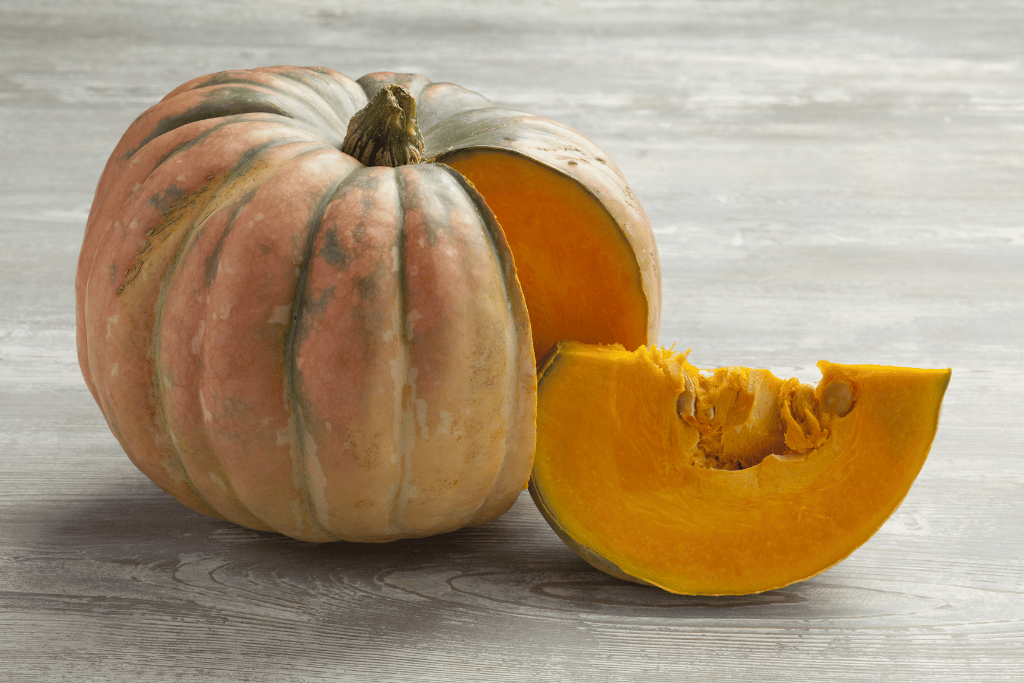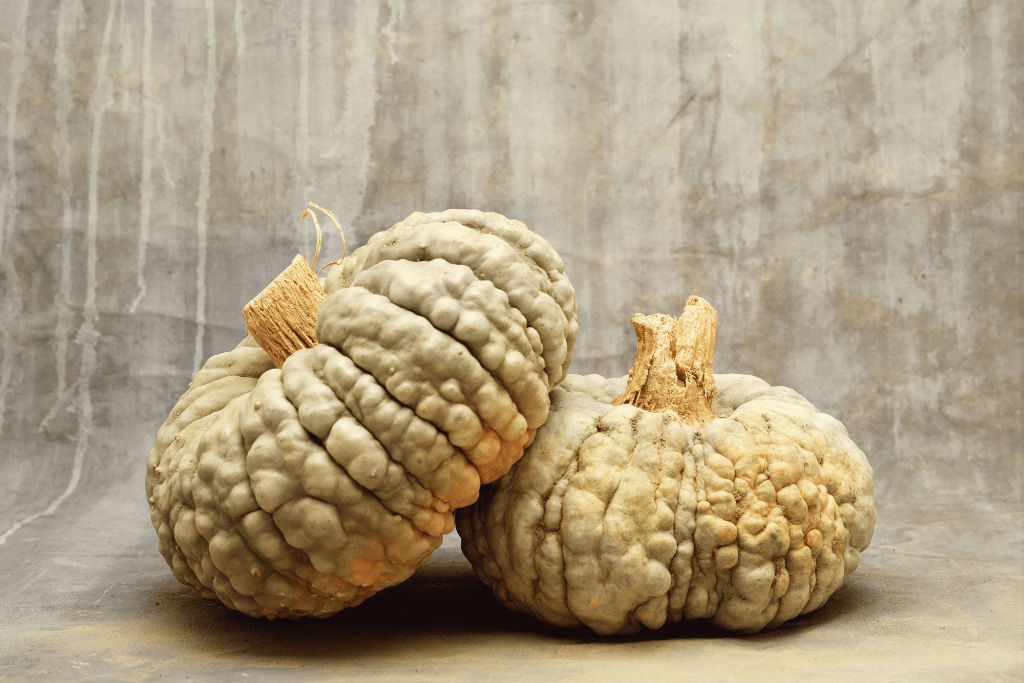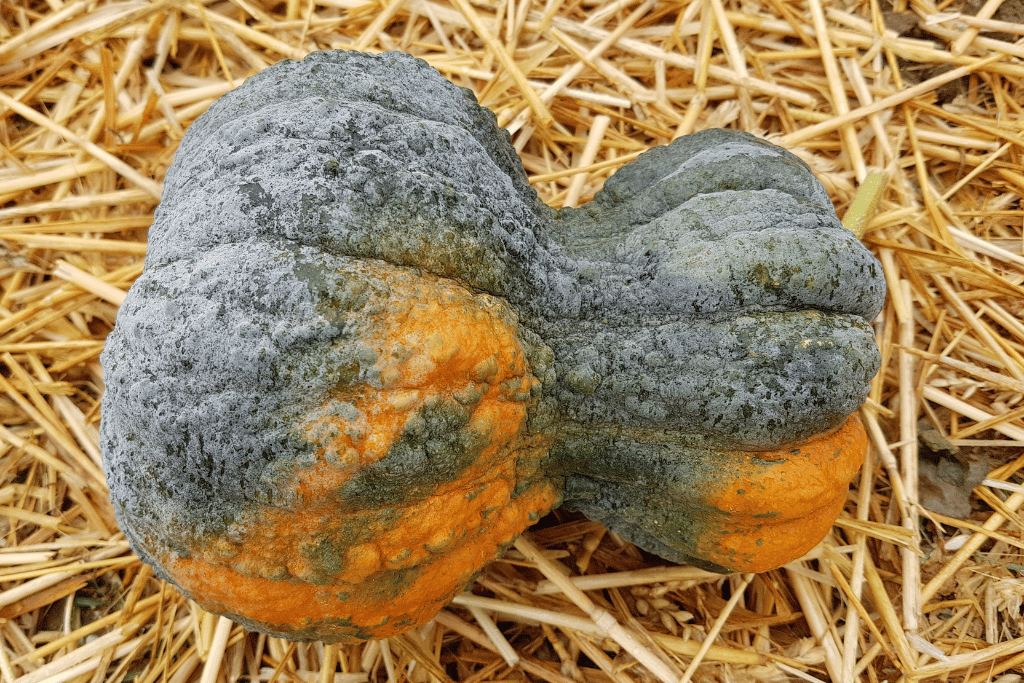When we think of pumpkins, the first color that comes to mind is orange, right? But did you know that there are green pumpkin varieties along with white, yellow, and funky-patterned ones? Green squashes in particular may not be the most conventional choice, but don’t be concerned by their color – they’re not unripe! That’s their permanent shade. And these quirky gourds aren’t just for indoor or porch decoration either. They’re actually quite versatile, making for some delicious and unique culinary creations. So, let’s put our gardening gloves on, and dig up all there is to know about the verdant types of this fruit.

The Interesting Phenomenon Behind The Green Color
When it comes to pumpkins, we are susceptible to associating them with the good old jack-o’-lantern we carve and display on the patio in the fall spirit. These squashes start as green fruits on the plant itself and acquire their vibrant orange shade when they hit maturity.
However, multiple kinds of pumpkins remain green throughout their whole life cycle. But how come?
Well, the answer lies in genetics. Green pumpkin varieties have a mutation in their genes that affects the production of chlorophyll, the pigment that gives plants their green color. This interesting occurrence is the reason for certain types of pumpkins not changing color throughout their growth from sprouts to fully ripe fruits.
Picture gourds like a special offer in the supermarket: you purchase an item that has so much more to it than you would originally think. What’s especially fun about green pumpkins is that they come in lots of different shades, ranging from bright to more toned-down hues. They also have diverse textures, with some of them flaunting smooth skin, while others grab gardeners’ attention with their bumpy or ribbed exterior.
Despite their unique appearance, these squashes are just as multifaceted as their orange counterparts. They make an exciting ingredient in several recipes, including soups, stews, and pies, and can even be roasted and eaten as a side dish.
Uses of Green Pumpkin Varieties
Since breeding plants for new unusual physical appearances kicked in about a decade ago, ordinary greens are just not that special anymore. The more unique shape, shade, and pattern the better! Extraordinary-colored pumpkins are an excellent example of this, and their versatile usage makes them one of the most sought-after products in supermarkets and farmer’s markets. And for a good reason.
Firstly, these verdant harbingers of fall look really tasteful as home decorations. For example, large green pumpkin varieties instantly make any front yard, veranda, or gazebo exquisite, especially when combined with other odd-looking gourds. In interior spaces, smaller ones are quite the show-stoppers as centerpieces on dinner tables, coffee tables, or cupboards. Moreover, companion planting pumpkins allows them to flourish and thrive in outdoor gardens, particularly when planted alongside certain pumpkin-friendly companion plants. One thing’s for sure: whichever size or shade you pick; you’ll have an outstanding piece of décor to enjoy for weeks without rotting or spoiling.
We’ve already mentioned how easy it is to process green pumpkins in the kitchen. Depending on the type of fruit, it may carry a slightly sweet or nutty flavor, which makes any kind of dish more exciting right away. Pumpkins are also an excellent source of vitamins A and C, as well as potassium and fiber. Roasting them can also bring out their natural sweetness and make for a tasty garnish.
But wait, there’s more! Green squashes are also popular arts and crafts staples, as their hard exterior can be carved or painted for a unique project. Some people even use them as a makeshift birdhouse, creating a hole for birds to nest in. In addition, some gardeners use these types of greens to make their own organic fertilizer, as the seeds and pulp can be composted.
Different Green Pumpkin Varieties
1. Speckled Hound

If you’re searching for a real head-turner to jazz up your exterior or empty corners in your home, go for the Speckled Hound, which originates from the U.S. It’s the perfect middle-ground between an ordinary and unusual pumpkin, as its skin mixes orange and green stripes.
They usually range in size from small to medium, with an average weight of 8-10 pounds. When mature, they have a hard, dense texture and a sweet, nutty flavor. The striking appearance of the speckled hound makes it an excellent choice for fall decoration and adds some liveliness to any ornamental display.
2. Marina di Chioggia

Moving from the North American continent to the European one, we find Marina di Chioggia, an heirloom type hailing from Italy with a striking physical appearance. From the dark green pumpkin varieties, this squash boasts probably the most unforgettable texture with its skin covered in bumps.
Internally, its flesh is a bright orange hue and possesses a dense, creamy texture ideal for roasting or use in soups and stews. The cultivar’s unique aesthetic qualities also make it a popular decorative element during autumnal celebrations.
3. Kabocha

The kabocha, originally from Japan is regarded by locals as a true gem. This small squash has a deep green color to it with lighter green speckles all around it. Its thick flesh is vibrant orange or yellow and is so sweet on the lips that it almost feels like eating a sweet potatoes.
4. Triamble

Among the green pumpkin varieties, the Triamble squash stands out of the crowd. Its distinct three-lobed shape makes it almost look like a squished sphere. The fruit is usually medium-sized, weighing about 10-15 pounds. So, if you’re looking for a pumpkin that’s a little different from the usual round or oblong form, definitely give it a try. It’s not just a feast for the eyes but also for the taste buds!
5. Shishigatani

We’re back in Japan for one more round of beautiful dark green pumpkin varieties. The Shishigatani gourd is a small to medium-sized heirloom pumpkin with a breathtaking hourglass shape. It has a ribbed, warty rind, which further adds to its aesthetically pleasing character. Renowned for its fine-grained flesh and well-rounded earthy taste, it’s highly sought after as a gourmet culinary ingredient.
6. Jarrahdale

The Jarrahdale pumpkin is not your typical round, orange-skinned gourd. Rather, it boasts a unique, blue-ish green color with deep grooves. Despite its unusual appearance, the flesh of this medium to large squash is bright orange and highly sought-after for its mellow taste. It’s a visually stunning and delicious addition to any table.
Named after a town in Western Australia, the Jarrahdale is widely popular in the continent, earned for its versatility in usage. Also, this fruit is a product of careful hybridization, as it’s a cross between the Cinderella pumpkin and Blue Hubbard squash, inheriting attributes from both.
7. Yokohama

The Yokohama squash is a unique variety of the well-known fruit that has a distinctive round and flattened shape. It is easily recognizable by the large depression at the stem end, which adds to its character. Its skin is dark green and bumpy, with deep ribs that are covered in a silvery bloom. Measuring around 20 centimeters in diameter and 10 centimeters in height, this gourd is considered to be a medium-sized fruit, weighing between 4 to 6 pounds. The dark orange color and fine-grained texture of its flesh make it a delight to eat. It is also notable for having a small seed cavity, making the squash very efficient to prepare.
Conclusion
Who knew there was so much more to pumpkins than the typical orange jack-o’-lantern? Green pumpkin varieties are an excellent way to add some quirkiness and unique flavors to your culinary creations. From the Speckled Hound to the Yokohama squash, there’s no shortage of interesting varieties to explore. And if cooking isn’t your thing, these gourds make for outstanding décor pieces or arts and crafts projects. So don’t be afraid to branch out and try something new – you never know what you might discover!
Frequently Asked Questions (FAQ)
What makes pumpkin varieties green?
Certain types of pumpkins remain green throughout their entire life cycle due to a genetic mutation that reduces the production of chlorophyll. Chlorophyll is a pigment responsible for giving plants their green color and is necessary for photosynthesis. As a result of the mutation, these green pumpkins exhibit their unique coloration. The mutation is inherited by subsequent generations, which leads to the perpetuation of the green color. Despite this genetic variation, these pumpkins have similar nutritional and culinary properties as the more common orange varieties.
What are the physical characteristics of green pumpkins?
These special kinds of fruits come in different shades of green and have various textures, from smooth to bumpy or ribbed exteriors. They vary in size and weight, with some being small and others medium to large. Despite their unusual appearance, the flesh of green pumpkins is similar to their orange counterparts, with a dense texture and a slightly sweet, earthy, or nutty flavor.
Where can I find green pumpkin varieties?
These special gourds can typically be found at local farmer’s markets, specialty grocery stores, and sometimes even at larger supermarkets. They are most commonly available in the fall, during pumpkin season, but can sometimes be found year-round. Garden centers and nurseries may also carry green pumpkin seeds or seedlings for those interested in growing their own. Additionally, many online seed retailers offer a wide variety of green pumpkin seeds, making it easy to find and try different types of plants in your home garden.
How should I care for my green pumpkin?
They require similar care to other types of pumpkins. They should be planted in well-drained soil that is rich in organic matter, with regular watering and fertilization. It’s important to provide adequate space for the vines to grow and support the weight of the fruit, and to remove any weeds or competing plants that may hinder growth. Each variety may have specific needs, such as requiring more or less water or a longer growing season, so it’s important to research the particular type of pumpkin being grown to provide optimal care. Regular harvesting is also important, as leaving them on the vine for too long can lead to rotting or other damage.



